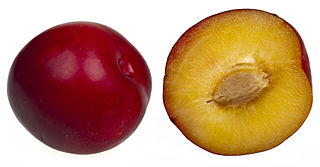The BBCH-scale (stone) identifies the phenological development stages of stone fruit (cherry = Prunus cerasus, plum = Prunus domestica ssp. domestica, peach = Prunus persica, apricot = Prunus armeniaca). It is a plant species specific version of the BBCH-scale.

A cherry is the fruit of many plants of the genus Prunus, and is a fleshy drupe.

A plum is a fruit of the subgenus Prunus of the genus Prunus. The subgenus is distinguished from other subgenera in the shoots having terminal bud and solitary side buds, the flowers in groups of one to five together on short stems, and the fruit having a groove running down one side and a smooth stone.

The peach is a deciduous tree native to the region of Northwest China between the Tarim Basin and the north slopes of the Kunlun Mountains, where it was first domesticated and cultivated. It bears an edible juicy fruit called a peach or a nectarine.
| Phenological growth stages and BBCH-identification keys of stone fruit | |
|---|---|
| Code | Description |
| Principal growth stage 0: Sprouting/Bud development | |
| 00 | Dormancy: leaf buds and the thicker inflorescence buds closed and covered by dark brown scales |
| 01 | Beginning of bud swelling (leaf buds); light brown scales visible, scales with light coloured edges |
| 03 | End of leaf bud swelling: scales separated, light green bud sections visible |
| 09 | Green leaf tips visible: brown scales fallen, buds enclosed by light green scales |
| Principal growth stage 1: Leaf development | |
| 10 | First leaves separating: green scales slightly open, leaves emerging |
| 11 | First leaves unfolded, axis of developing shoot visible |
| 19 | First leaves fully expanded |
| Principal growth stage 3: Shoot development1 | |
| 31 | Beginning of shoot growth: axes of developing shoots visible |
| 32 | Shoots about 20% of final length |
| 33 | Shoots about 30% of final length |
| 3 . | Stages continuous till . . . |
| 39 | Shoots about 90% of final length |
| Principal growth stage 5: Inflorescence emergence | |
| 51 | Inflorescence buds swelling: buds closed, light brown scales visible |
| 53 | Bud burst: scales separated, light green bud sections visible |
| 54 | Inflorescence enclosed by light green scales, if such scales are formed (not all cultivars) |
| 55 | Single flower buds visible (still closed) borne on short stalks, green scales slightly open |
| 56 | Flower pedicel elongating; sepals closed; single flowers separating |
| 57 | Sepals open: petal tips visible; single flowers with white or pink petals (still closed) |
| 59 | Most flowers with petals forming a hollow ball |
| Principal growth stage 6: Flowering | |
| 60 | First flowers open |
| 61 | Beginning of flowering: about 10% of flowers open |
| 62 | About 20% of flowers open |
| 63 | About 30% of flowers open |
| 64 | About 40% of flowers open |
| 65 | Full flowering: at least 50% of flowers open, first petals falling |
| 67 | Flowers fading: majority of petals fallen |
| 69 | End of flowering: all petals fallen |
| Principal growth stage 7: Development of fruit | |
| 71 | Ovary growing; fruit fall after flowering |
| 72 | Green ovary surrounded by dying sepal crown, sepals beginning to fall |
| 73 | Second fruit fall |
| 75 | Fruit about half final size |
| 76 | Fruit about 60% of final size |
| 77 | Fruit about 70% of final size |
| 78 | Fruit about 80% of final size |
| 79 | Fruit about 90% of final size |
| Principal growth stage 8: Maturity of fruit and seed | |
| 81 | Beginning of fruit colouring |
| 85 | Colouring advanced |
| 87 | Fruit ripe for picking |
| 89 | Fruit ripe for consumption: fruit have typical taste and firmness |
| Principal growth stage 9: Senescence, beginning of dormancy | |
| 91 | Shoot growth completed; foliage still fully green |
| 92 | Leaves begin to discolour |
| 93 | Beginning of leaf fall |
| 95 | 50% of leaves discoloured or fallen |
| 97 | All leaves fallen |
| 99 | Harvested product |
1 From terminal bud

